Strategic Planning in Hospitality: Factors, Metrics, and Changes
VerifiedAdded on 2023/01/18
|12
|3781
|78
Report
AI Summary
This report provides a comprehensive analysis of strategic planning within the hospitality industry, using British Airways as a case study. It begins by critically analyzing factors affecting the successful implementation of strategies across key business functions, including leadership, structural design, information and control systems, and human resources. The report then evaluates various performance metrics, such as critical success factors, key performance indicators (KPIs), and the balance score card, and their impact on business strategies. It highlights the importance of aligning KPIs with strategic objectives and the potential pitfalls of focusing on easily measurable metrics or using KPIs solely for employee control. Finally, the report critically evaluates key elements in managing strategic changes and leading types of strategic changes, providing a holistic understanding of strategic management in the hospitality sector. The report emphasizes the need for effective communication, structural design, and human resource management for successful strategy implementation.
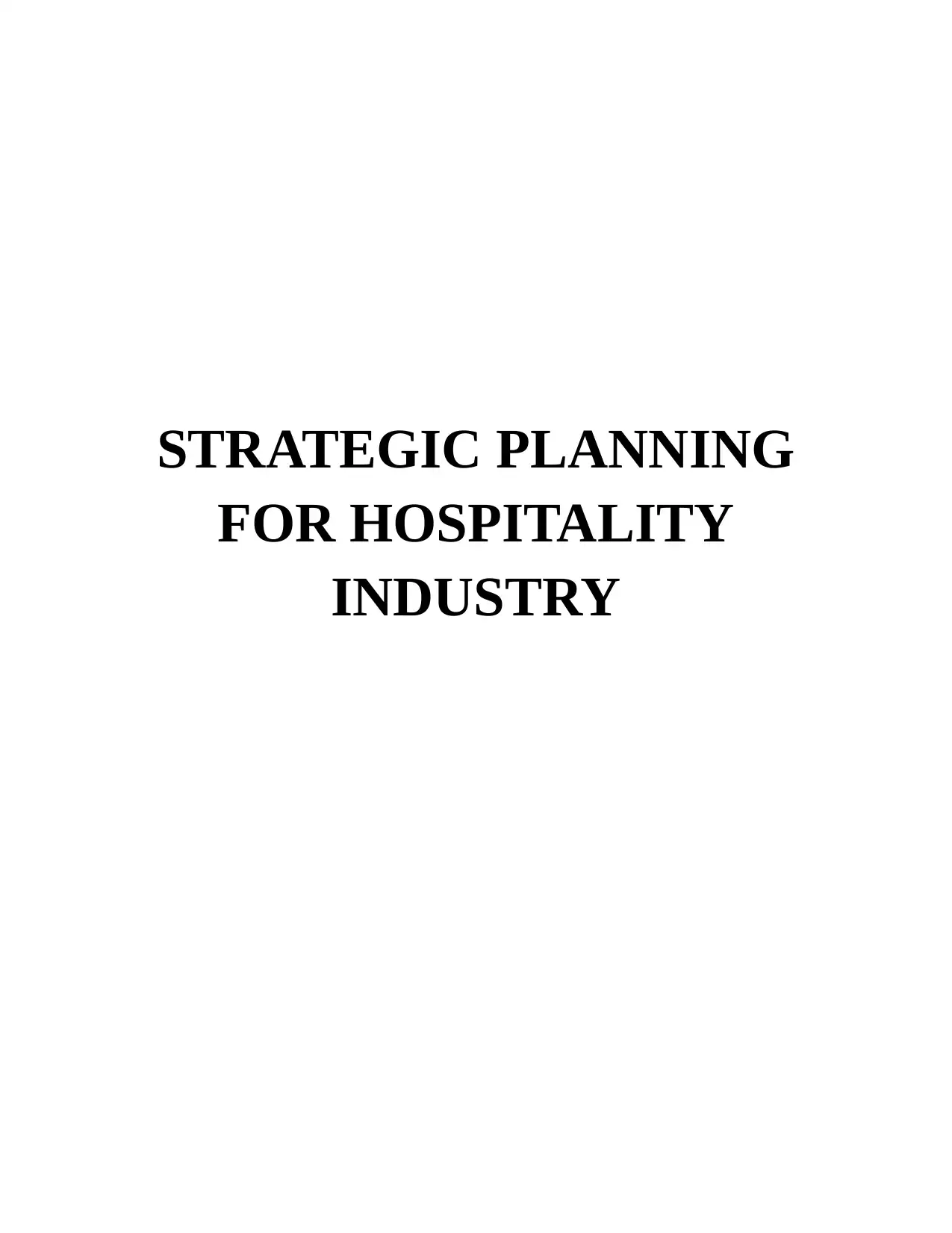
STRATEGIC PLANNING
FOR HOSPITALITY
INDUSTRY
FOR HOSPITALITY
INDUSTRY
Paraphrase This Document
Need a fresh take? Get an instant paraphrase of this document with our AI Paraphraser
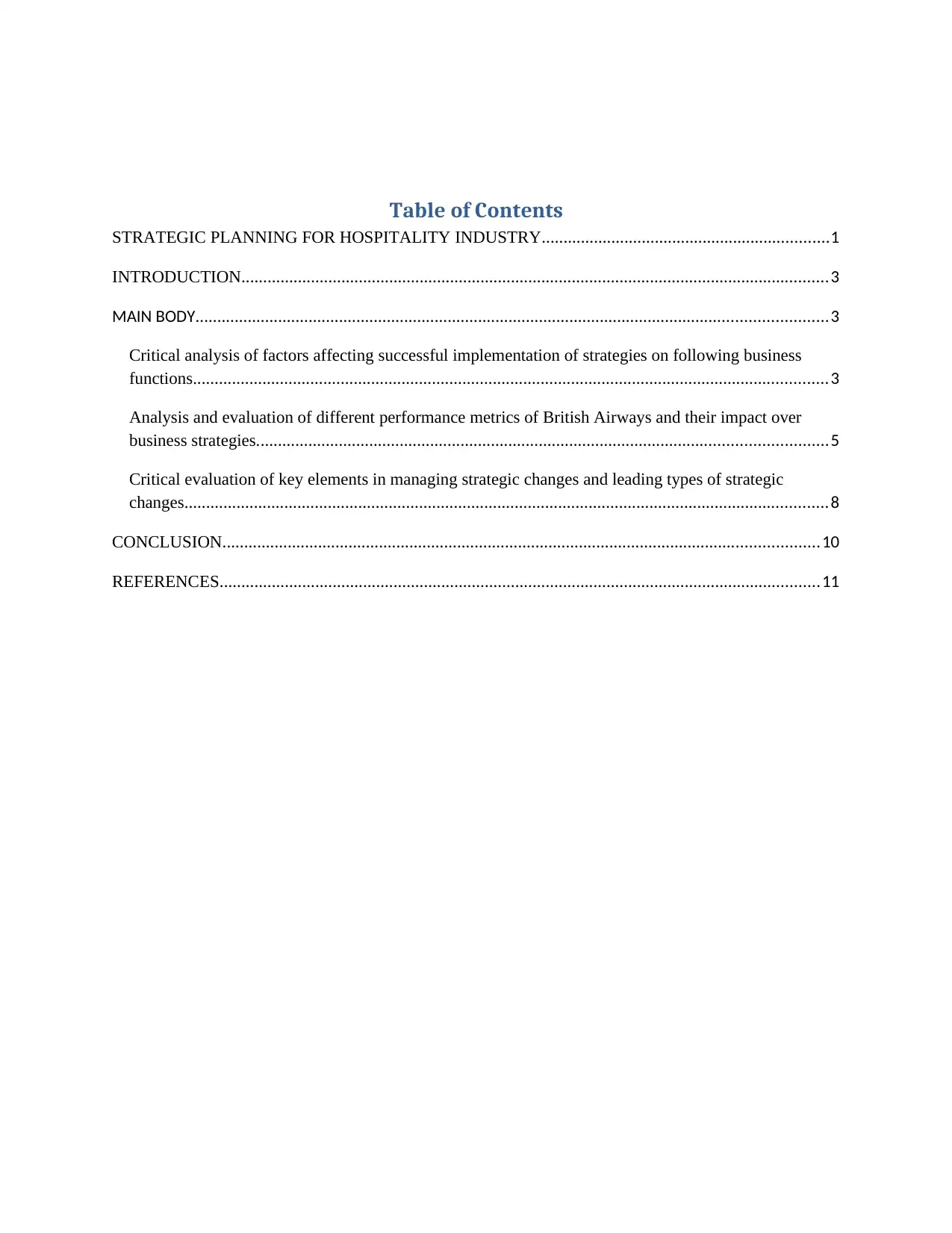
Table of Contents
STRATEGIC PLANNING FOR HOSPITALITY INDUSTRY..................................................................1
INTRODUCTION.......................................................................................................................................3
MAIN BODY.................................................................................................................................................3
Critical analysis of factors affecting successful implementation of strategies on following business
functions..................................................................................................................................................3
Analysis and evaluation of different performance metrics of British Airways and their impact over
business strategies...................................................................................................................................5
Critical evaluation of key elements in managing strategic changes and leading types of strategic
changes....................................................................................................................................................8
CONCLUSION.........................................................................................................................................10
REFERENCES..........................................................................................................................................11
STRATEGIC PLANNING FOR HOSPITALITY INDUSTRY..................................................................1
INTRODUCTION.......................................................................................................................................3
MAIN BODY.................................................................................................................................................3
Critical analysis of factors affecting successful implementation of strategies on following business
functions..................................................................................................................................................3
Analysis and evaluation of different performance metrics of British Airways and their impact over
business strategies...................................................................................................................................5
Critical evaluation of key elements in managing strategic changes and leading types of strategic
changes....................................................................................................................................................8
CONCLUSION.........................................................................................................................................10
REFERENCES..........................................................................................................................................11
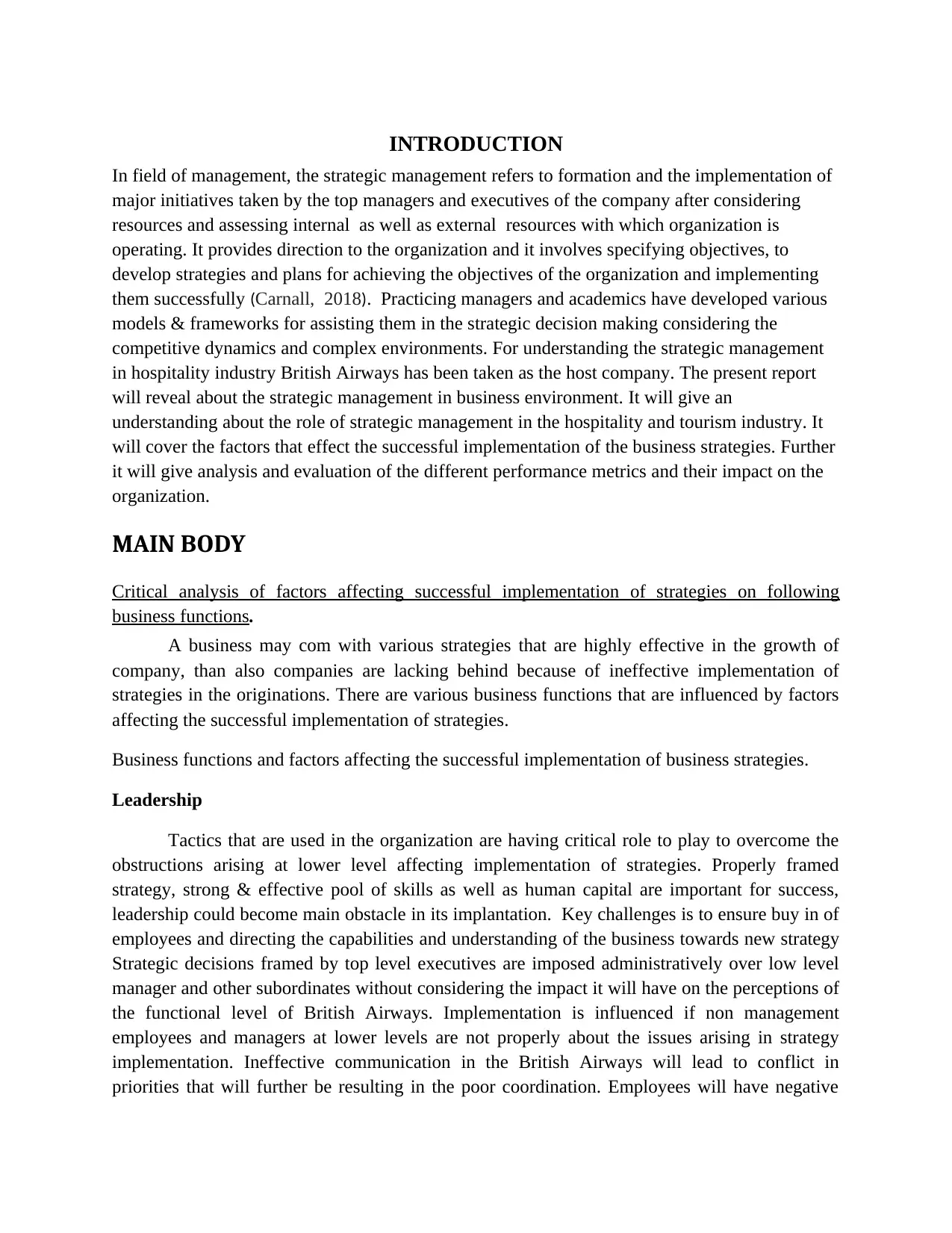
INTRODUCTION
In field of management, the strategic management refers to formation and the implementation of
major initiatives taken by the top managers and executives of the company after considering
resources and assessing internal as well as external resources with which organization is
operating. It provides direction to the organization and it involves specifying objectives, to
develop strategies and plans for achieving the objectives of the organization and implementing
them successfully (Carnall, 2018). Practicing managers and academics have developed various
models & frameworks for assisting them in the strategic decision making considering the
competitive dynamics and complex environments. For understanding the strategic management
in hospitality industry British Airways has been taken as the host company. The present report
will reveal about the strategic management in business environment. It will give an
understanding about the role of strategic management in the hospitality and tourism industry. It
will cover the factors that effect the successful implementation of the business strategies. Further
it will give analysis and evaluation of the different performance metrics and their impact on the
organization.
MAIN BODY
Critical analysis of factors affecting successful implementation of strategies on following
business functions.
A business may com with various strategies that are highly effective in the growth of
company, than also companies are lacking behind because of ineffective implementation of
strategies in the originations. There are various business functions that are influenced by factors
affecting the successful implementation of strategies.
Business functions and factors affecting the successful implementation of business strategies.
Leadership
Tactics that are used in the organization are having critical role to play to overcome the
obstructions arising at lower level affecting implementation of strategies. Properly framed
strategy, strong & effective pool of skills as well as human capital are important for success,
leadership could become main obstacle in its implantation. Key challenges is to ensure buy in of
employees and directing the capabilities and understanding of the business towards new strategy
Strategic decisions framed by top level executives are imposed administratively over low level
manager and other subordinates without considering the impact it will have on the perceptions of
the functional level of British Airways. Implementation is influenced if non management
employees and managers at lower levels are not properly about the issues arising in strategy
implementation. Ineffective communication in the British Airways will lead to conflict in
priorities that will further be resulting in the poor coordination. Employees will have negative
In field of management, the strategic management refers to formation and the implementation of
major initiatives taken by the top managers and executives of the company after considering
resources and assessing internal as well as external resources with which organization is
operating. It provides direction to the organization and it involves specifying objectives, to
develop strategies and plans for achieving the objectives of the organization and implementing
them successfully (Carnall, 2018). Practicing managers and academics have developed various
models & frameworks for assisting them in the strategic decision making considering the
competitive dynamics and complex environments. For understanding the strategic management
in hospitality industry British Airways has been taken as the host company. The present report
will reveal about the strategic management in business environment. It will give an
understanding about the role of strategic management in the hospitality and tourism industry. It
will cover the factors that effect the successful implementation of the business strategies. Further
it will give analysis and evaluation of the different performance metrics and their impact on the
organization.
MAIN BODY
Critical analysis of factors affecting successful implementation of strategies on following
business functions.
A business may com with various strategies that are highly effective in the growth of
company, than also companies are lacking behind because of ineffective implementation of
strategies in the originations. There are various business functions that are influenced by factors
affecting the successful implementation of strategies.
Business functions and factors affecting the successful implementation of business strategies.
Leadership
Tactics that are used in the organization are having critical role to play to overcome the
obstructions arising at lower level affecting implementation of strategies. Properly framed
strategy, strong & effective pool of skills as well as human capital are important for success,
leadership could become main obstacle in its implantation. Key challenges is to ensure buy in of
employees and directing the capabilities and understanding of the business towards new strategy
Strategic decisions framed by top level executives are imposed administratively over low level
manager and other subordinates without considering the impact it will have on the perceptions of
the functional level of British Airways. Implementation is influenced if non management
employees and managers at lower levels are not properly about the issues arising in strategy
implementation. Ineffective communication in the British Airways will lead to conflict in
priorities that will further be resulting in the poor coordination. Employees will have negative
⊘ This is a preview!⊘
Do you want full access?
Subscribe today to unlock all pages.

Trusted by 1+ million students worldwide
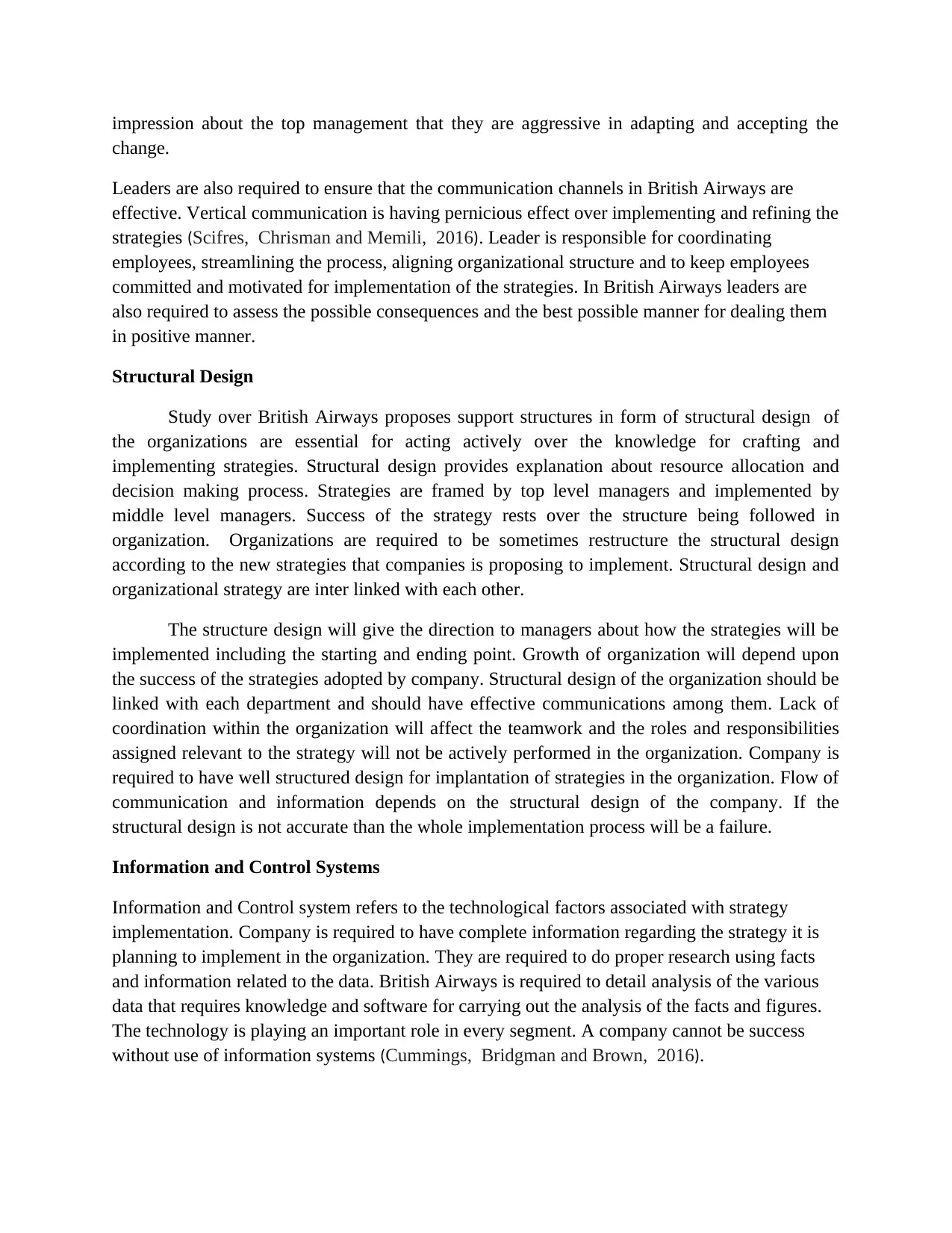
impression about the top management that they are aggressive in adapting and accepting the
change.
Leaders are also required to ensure that the communication channels in British Airways are
effective. Vertical communication is having pernicious effect over implementing and refining the
strategies (Scifres, Chrisman and Memili, 2016). Leader is responsible for coordinating
employees, streamlining the process, aligning organizational structure and to keep employees
committed and motivated for implementation of the strategies. In British Airways leaders are
also required to assess the possible consequences and the best possible manner for dealing them
in positive manner.
Structural Design
Study over British Airways proposes support structures in form of structural design of
the organizations are essential for acting actively over the knowledge for crafting and
implementing strategies. Structural design provides explanation about resource allocation and
decision making process. Strategies are framed by top level managers and implemented by
middle level managers. Success of the strategy rests over the structure being followed in
organization. Organizations are required to be sometimes restructure the structural design
according to the new strategies that companies is proposing to implement. Structural design and
organizational strategy are inter linked with each other.
The structure design will give the direction to managers about how the strategies will be
implemented including the starting and ending point. Growth of organization will depend upon
the success of the strategies adopted by company. Structural design of the organization should be
linked with each department and should have effective communications among them. Lack of
coordination within the organization will affect the teamwork and the roles and responsibilities
assigned relevant to the strategy will not be actively performed in the organization. Company is
required to have well structured design for implantation of strategies in the organization. Flow of
communication and information depends on the structural design of the company. If the
structural design is not accurate than the whole implementation process will be a failure.
Information and Control Systems
Information and Control system refers to the technological factors associated with strategy
implementation. Company is required to have complete information regarding the strategy it is
planning to implement in the organization. They are required to do proper research using facts
and information related to the data. British Airways is required to detail analysis of the various
data that requires knowledge and software for carrying out the analysis of the facts and figures.
The technology is playing an important role in every segment. A company cannot be success
without use of information systems (Cummings, Bridgman and Brown, 2016).
change.
Leaders are also required to ensure that the communication channels in British Airways are
effective. Vertical communication is having pernicious effect over implementing and refining the
strategies (Scifres, Chrisman and Memili, 2016). Leader is responsible for coordinating
employees, streamlining the process, aligning organizational structure and to keep employees
committed and motivated for implementation of the strategies. In British Airways leaders are
also required to assess the possible consequences and the best possible manner for dealing them
in positive manner.
Structural Design
Study over British Airways proposes support structures in form of structural design of
the organizations are essential for acting actively over the knowledge for crafting and
implementing strategies. Structural design provides explanation about resource allocation and
decision making process. Strategies are framed by top level managers and implemented by
middle level managers. Success of the strategy rests over the structure being followed in
organization. Organizations are required to be sometimes restructure the structural design
according to the new strategies that companies is proposing to implement. Structural design and
organizational strategy are inter linked with each other.
The structure design will give the direction to managers about how the strategies will be
implemented including the starting and ending point. Growth of organization will depend upon
the success of the strategies adopted by company. Structural design of the organization should be
linked with each department and should have effective communications among them. Lack of
coordination within the organization will affect the teamwork and the roles and responsibilities
assigned relevant to the strategy will not be actively performed in the organization. Company is
required to have well structured design for implantation of strategies in the organization. Flow of
communication and information depends on the structural design of the company. If the
structural design is not accurate than the whole implementation process will be a failure.
Information and Control Systems
Information and Control system refers to the technological factors associated with strategy
implementation. Company is required to have complete information regarding the strategy it is
planning to implement in the organization. They are required to do proper research using facts
and information related to the data. British Airways is required to detail analysis of the various
data that requires knowledge and software for carrying out the analysis of the facts and figures.
The technology is playing an important role in every segment. A company cannot be success
without use of information systems (Cummings, Bridgman and Brown, 2016).
Paraphrase This Document
Need a fresh take? Get an instant paraphrase of this document with our AI Paraphraser
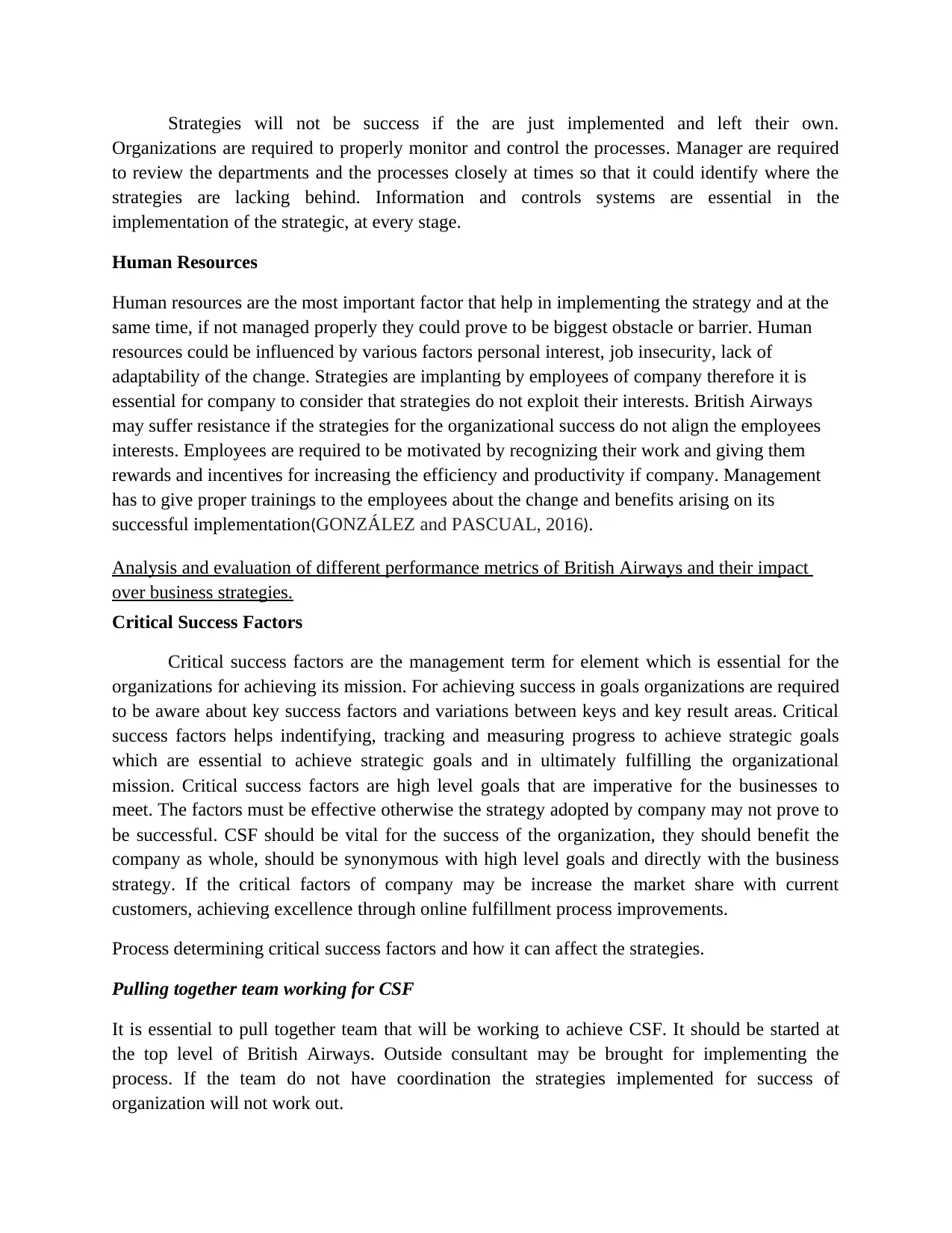
Strategies will not be success if the are just implemented and left their own.
Organizations are required to properly monitor and control the processes. Manager are required
to review the departments and the processes closely at times so that it could identify where the
strategies are lacking behind. Information and controls systems are essential in the
implementation of the strategic, at every stage.
Human Resources
Human resources are the most important factor that help in implementing the strategy and at the
same time, if not managed properly they could prove to be biggest obstacle or barrier. Human
resources could be influenced by various factors personal interest, job insecurity, lack of
adaptability of the change. Strategies are implanting by employees of company therefore it is
essential for company to consider that strategies do not exploit their interests. British Airways
may suffer resistance if the strategies for the organizational success do not align the employees
interests. Employees are required to be motivated by recognizing their work and giving them
rewards and incentives for increasing the efficiency and productivity if company. Management
has to give proper trainings to the employees about the change and benefits arising on its
successful implementation(GONZÁLEZ and PASCUAL, 2016).
Analysis and evaluation of different performance metrics of British Airways and their impact
over business strategies.
Critical Success Factors
Critical success factors are the management term for element which is essential for the
organizations for achieving its mission. For achieving success in goals organizations are required
to be aware about key success factors and variations between keys and key result areas. Critical
success factors helps indentifying, tracking and measuring progress to achieve strategic goals
which are essential to achieve strategic goals and in ultimately fulfilling the organizational
mission. Critical success factors are high level goals that are imperative for the businesses to
meet. The factors must be effective otherwise the strategy adopted by company may not prove to
be successful. CSF should be vital for the success of the organization, they should benefit the
company as whole, should be synonymous with high level goals and directly with the business
strategy. If the critical factors of company may be increase the market share with current
customers, achieving excellence through online fulfillment process improvements.
Process determining critical success factors and how it can affect the strategies.
Pulling together team working for CSF
It is essential to pull together team that will be working to achieve CSF. It should be started at
the top level of British Airways. Outside consultant may be brought for implementing the
process. If the team do not have coordination the strategies implemented for success of
organization will not work out.
Organizations are required to properly monitor and control the processes. Manager are required
to review the departments and the processes closely at times so that it could identify where the
strategies are lacking behind. Information and controls systems are essential in the
implementation of the strategic, at every stage.
Human Resources
Human resources are the most important factor that help in implementing the strategy and at the
same time, if not managed properly they could prove to be biggest obstacle or barrier. Human
resources could be influenced by various factors personal interest, job insecurity, lack of
adaptability of the change. Strategies are implanting by employees of company therefore it is
essential for company to consider that strategies do not exploit their interests. British Airways
may suffer resistance if the strategies for the organizational success do not align the employees
interests. Employees are required to be motivated by recognizing their work and giving them
rewards and incentives for increasing the efficiency and productivity if company. Management
has to give proper trainings to the employees about the change and benefits arising on its
successful implementation(GONZÁLEZ and PASCUAL, 2016).
Analysis and evaluation of different performance metrics of British Airways and their impact
over business strategies.
Critical Success Factors
Critical success factors are the management term for element which is essential for the
organizations for achieving its mission. For achieving success in goals organizations are required
to be aware about key success factors and variations between keys and key result areas. Critical
success factors helps indentifying, tracking and measuring progress to achieve strategic goals
which are essential to achieve strategic goals and in ultimately fulfilling the organizational
mission. Critical success factors are high level goals that are imperative for the businesses to
meet. The factors must be effective otherwise the strategy adopted by company may not prove to
be successful. CSF should be vital for the success of the organization, they should benefit the
company as whole, should be synonymous with high level goals and directly with the business
strategy. If the critical factors of company may be increase the market share with current
customers, achieving excellence through online fulfillment process improvements.
Process determining critical success factors and how it can affect the strategies.
Pulling together team working for CSF
It is essential to pull together team that will be working to achieve CSF. It should be started at
the top level of British Airways. Outside consultant may be brought for implementing the
process. If the team do not have coordination the strategies implemented for success of
organization will not work out.
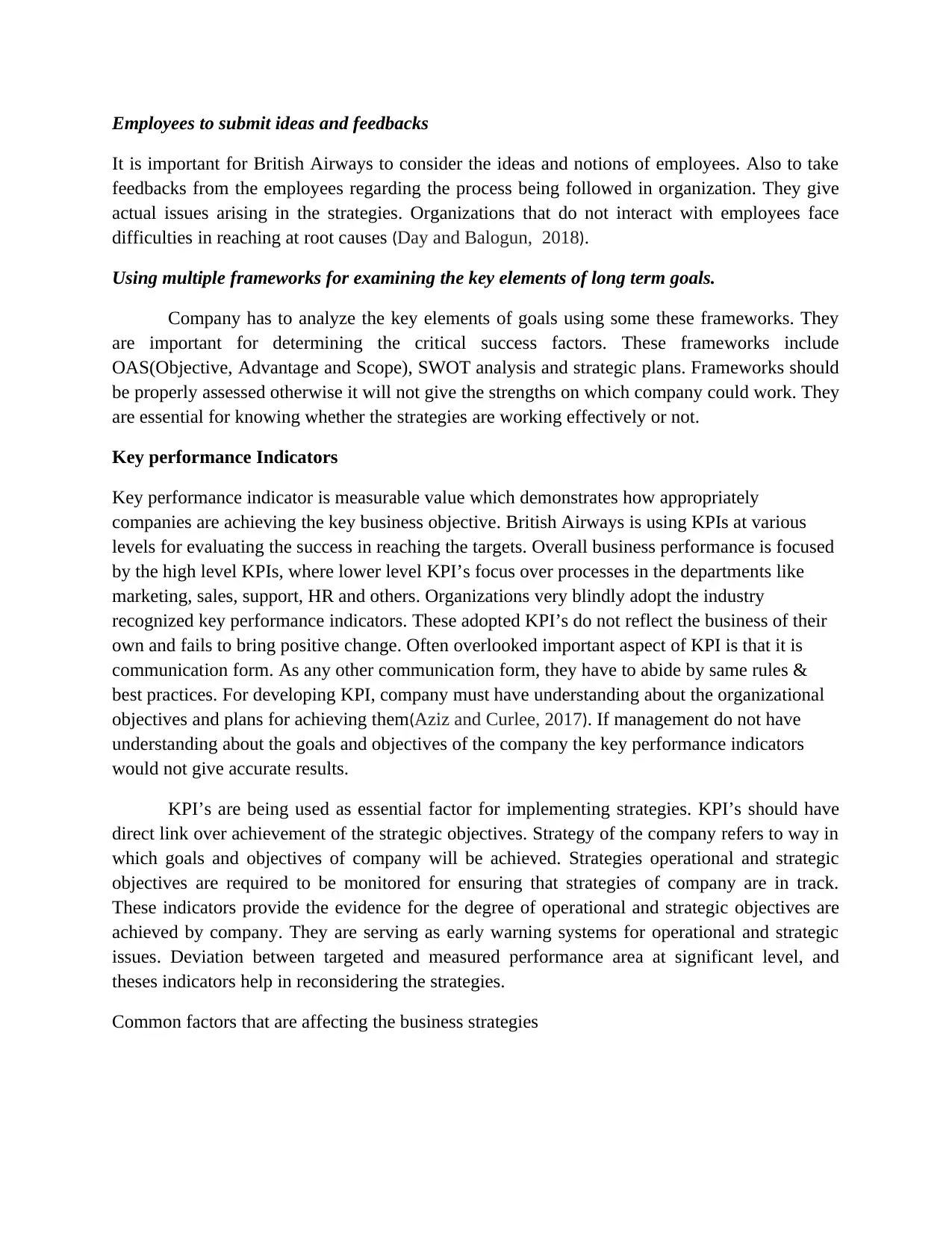
Employees to submit ideas and feedbacks
It is important for British Airways to consider the ideas and notions of employees. Also to take
feedbacks from the employees regarding the process being followed in organization. They give
actual issues arising in the strategies. Organizations that do not interact with employees face
difficulties in reaching at root causes (Day and Balogun, 2018).
Using multiple frameworks for examining the key elements of long term goals.
Company has to analyze the key elements of goals using some these frameworks. They
are important for determining the critical success factors. These frameworks include
OAS(Objective, Advantage and Scope), SWOT analysis and strategic plans. Frameworks should
be properly assessed otherwise it will not give the strengths on which company could work. They
are essential for knowing whether the strategies are working effectively or not.
Key performance Indicators
Key performance indicator is measurable value which demonstrates how appropriately
companies are achieving the key business objective. British Airways is using KPIs at various
levels for evaluating the success in reaching the targets. Overall business performance is focused
by the high level KPIs, where lower level KPI’s focus over processes in the departments like
marketing, sales, support, HR and others. Organizations very blindly adopt the industry
recognized key performance indicators. These adopted KPI’s do not reflect the business of their
own and fails to bring positive change. Often overlooked important aspect of KPI is that it is
communication form. As any other communication form, they have to abide by same rules &
best practices. For developing KPI, company must have understanding about the organizational
objectives and plans for achieving them(Aziz and Curlee, 2017). If management do not have
understanding about the goals and objectives of the company the key performance indicators
would not give accurate results.
KPI’s are being used as essential factor for implementing strategies. KPI’s should have
direct link over achievement of the strategic objectives. Strategy of the company refers to way in
which goals and objectives of company will be achieved. Strategies operational and strategic
objectives are required to be monitored for ensuring that strategies of company are in track.
These indicators provide the evidence for the degree of operational and strategic objectives are
achieved by company. They are serving as early warning systems for operational and strategic
issues. Deviation between targeted and measured performance area at significant level, and
theses indicators help in reconsidering the strategies.
Common factors that are affecting the business strategies
It is important for British Airways to consider the ideas and notions of employees. Also to take
feedbacks from the employees regarding the process being followed in organization. They give
actual issues arising in the strategies. Organizations that do not interact with employees face
difficulties in reaching at root causes (Day and Balogun, 2018).
Using multiple frameworks for examining the key elements of long term goals.
Company has to analyze the key elements of goals using some these frameworks. They
are important for determining the critical success factors. These frameworks include
OAS(Objective, Advantage and Scope), SWOT analysis and strategic plans. Frameworks should
be properly assessed otherwise it will not give the strengths on which company could work. They
are essential for knowing whether the strategies are working effectively or not.
Key performance Indicators
Key performance indicator is measurable value which demonstrates how appropriately
companies are achieving the key business objective. British Airways is using KPIs at various
levels for evaluating the success in reaching the targets. Overall business performance is focused
by the high level KPIs, where lower level KPI’s focus over processes in the departments like
marketing, sales, support, HR and others. Organizations very blindly adopt the industry
recognized key performance indicators. These adopted KPI’s do not reflect the business of their
own and fails to bring positive change. Often overlooked important aspect of KPI is that it is
communication form. As any other communication form, they have to abide by same rules &
best practices. For developing KPI, company must have understanding about the organizational
objectives and plans for achieving them(Aziz and Curlee, 2017). If management do not have
understanding about the goals and objectives of the company the key performance indicators
would not give accurate results.
KPI’s are being used as essential factor for implementing strategies. KPI’s should have
direct link over achievement of the strategic objectives. Strategy of the company refers to way in
which goals and objectives of company will be achieved. Strategies operational and strategic
objectives are required to be monitored for ensuring that strategies of company are in track.
These indicators provide the evidence for the degree of operational and strategic objectives are
achieved by company. They are serving as early warning systems for operational and strategic
issues. Deviation between targeted and measured performance area at significant level, and
theses indicators help in reconsidering the strategies.
Common factors that are affecting the business strategies
⊘ This is a preview!⊘
Do you want full access?
Subscribe today to unlock all pages.

Trusted by 1+ million students worldwide
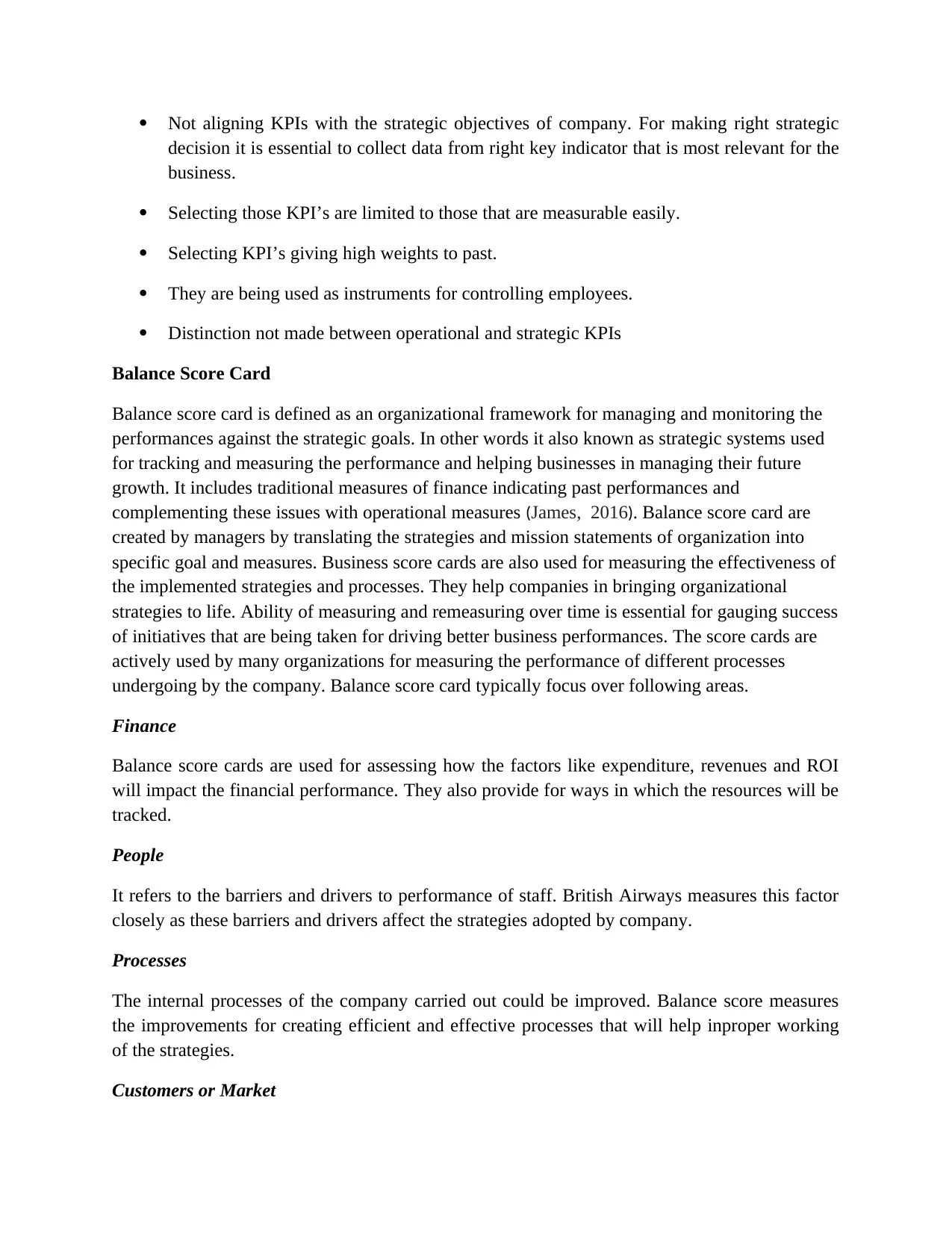
Not aligning KPIs with the strategic objectives of company. For making right strategic
decision it is essential to collect data from right key indicator that is most relevant for the
business.
Selecting those KPI’s are limited to those that are measurable easily.
Selecting KPI’s giving high weights to past.
They are being used as instruments for controlling employees.
Distinction not made between operational and strategic KPIs
Balance Score Card
Balance score card is defined as an organizational framework for managing and monitoring the
performances against the strategic goals. In other words it also known as strategic systems used
for tracking and measuring the performance and helping businesses in managing their future
growth. It includes traditional measures of finance indicating past performances and
complementing these issues with operational measures (James, 2016). Balance score card are
created by managers by translating the strategies and mission statements of organization into
specific goal and measures. Business score cards are also used for measuring the effectiveness of
the implemented strategies and processes. They help companies in bringing organizational
strategies to life. Ability of measuring and remeasuring over time is essential for gauging success
of initiatives that are being taken for driving better business performances. The score cards are
actively used by many organizations for measuring the performance of different processes
undergoing by the company. Balance score card typically focus over following areas.
Finance
Balance score cards are used for assessing how the factors like expenditure, revenues and ROI
will impact the financial performance. They also provide for ways in which the resources will be
tracked.
People
It refers to the barriers and drivers to performance of staff. British Airways measures this factor
closely as these barriers and drivers affect the strategies adopted by company.
Processes
The internal processes of the company carried out could be improved. Balance score measures
the improvements for creating efficient and effective processes that will help inproper working
of the strategies.
Customers or Market
decision it is essential to collect data from right key indicator that is most relevant for the
business.
Selecting those KPI’s are limited to those that are measurable easily.
Selecting KPI’s giving high weights to past.
They are being used as instruments for controlling employees.
Distinction not made between operational and strategic KPIs
Balance Score Card
Balance score card is defined as an organizational framework for managing and monitoring the
performances against the strategic goals. In other words it also known as strategic systems used
for tracking and measuring the performance and helping businesses in managing their future
growth. It includes traditional measures of finance indicating past performances and
complementing these issues with operational measures (James, 2016). Balance score card are
created by managers by translating the strategies and mission statements of organization into
specific goal and measures. Business score cards are also used for measuring the effectiveness of
the implemented strategies and processes. They help companies in bringing organizational
strategies to life. Ability of measuring and remeasuring over time is essential for gauging success
of initiatives that are being taken for driving better business performances. The score cards are
actively used by many organizations for measuring the performance of different processes
undergoing by the company. Balance score card typically focus over following areas.
Finance
Balance score cards are used for assessing how the factors like expenditure, revenues and ROI
will impact the financial performance. They also provide for ways in which the resources will be
tracked.
People
It refers to the barriers and drivers to performance of staff. British Airways measures this factor
closely as these barriers and drivers affect the strategies adopted by company.
Processes
The internal processes of the company carried out could be improved. Balance score measures
the improvements for creating efficient and effective processes that will help inproper working
of the strategies.
Customers or Market
Paraphrase This Document
Need a fresh take? Get an instant paraphrase of this document with our AI Paraphraser
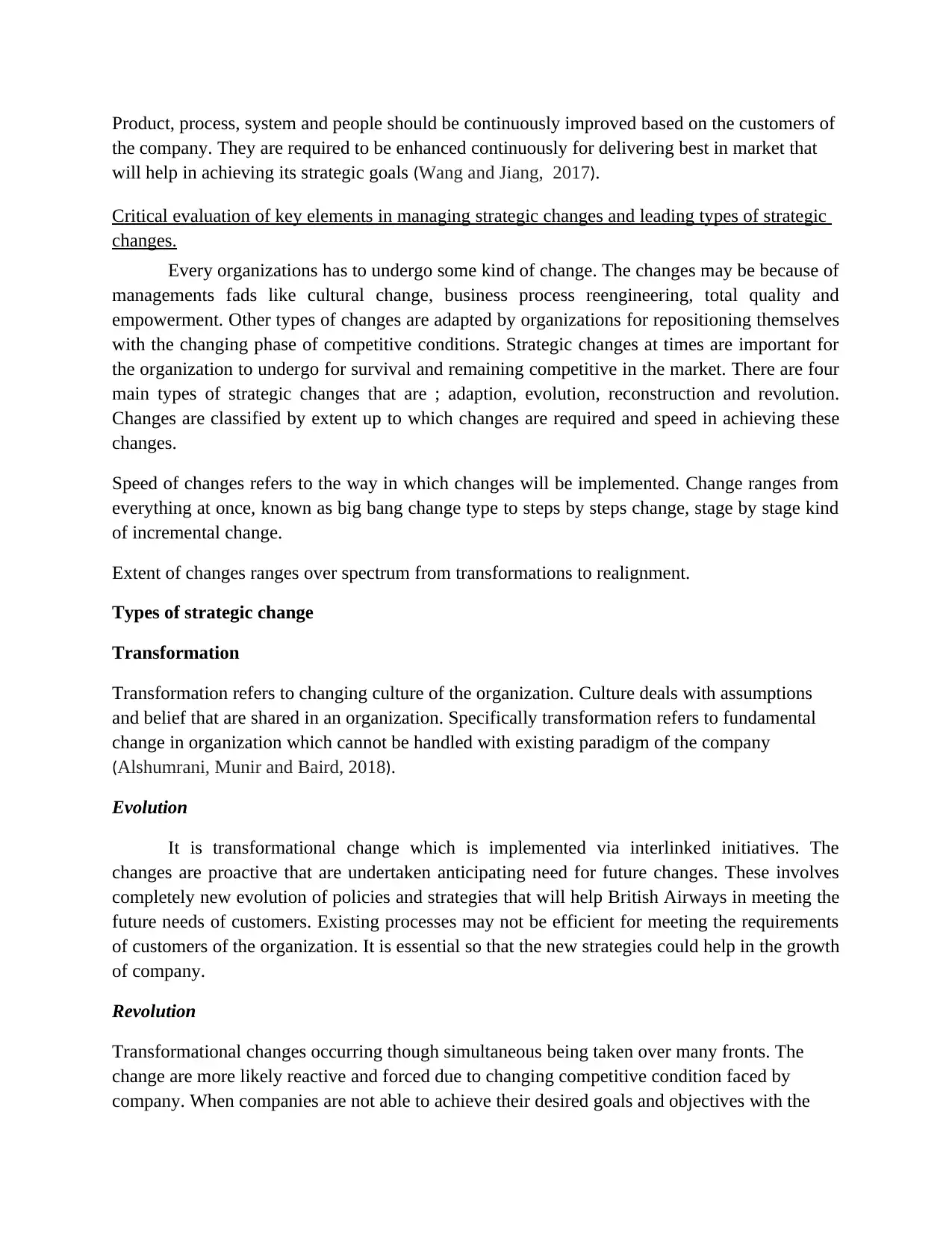
Product, process, system and people should be continuously improved based on the customers of
the company. They are required to be enhanced continuously for delivering best in market that
will help in achieving its strategic goals (Wang and Jiang, 2017).
Critical evaluation of key elements in managing strategic changes and leading types of strategic
changes.
Every organizations has to undergo some kind of change. The changes may be because of
managements fads like cultural change, business process reengineering, total quality and
empowerment. Other types of changes are adapted by organizations for repositioning themselves
with the changing phase of competitive conditions. Strategic changes at times are important for
the organization to undergo for survival and remaining competitive in the market. There are four
main types of strategic changes that are ; adaption, evolution, reconstruction and revolution.
Changes are classified by extent up to which changes are required and speed in achieving these
changes.
Speed of changes refers to the way in which changes will be implemented. Change ranges from
everything at once, known as big bang change type to steps by steps change, stage by stage kind
of incremental change.
Extent of changes ranges over spectrum from transformations to realignment.
Types of strategic change
Transformation
Transformation refers to changing culture of the organization. Culture deals with assumptions
and belief that are shared in an organization. Specifically transformation refers to fundamental
change in organization which cannot be handled with existing paradigm of the company
(Alshumrani, Munir and Baird, 2018).
Evolution
It is transformational change which is implemented via interlinked initiatives. The
changes are proactive that are undertaken anticipating need for future changes. These involves
completely new evolution of policies and strategies that will help British Airways in meeting the
future needs of customers. Existing processes may not be efficient for meeting the requirements
of customers of the organization. It is essential so that the new strategies could help in the growth
of company.
Revolution
Transformational changes occurring though simultaneous being taken over many fronts. The
change are more likely reactive and forced due to changing competitive condition faced by
company. When companies are not able to achieve their desired goals and objectives with the
the company. They are required to be enhanced continuously for delivering best in market that
will help in achieving its strategic goals (Wang and Jiang, 2017).
Critical evaluation of key elements in managing strategic changes and leading types of strategic
changes.
Every organizations has to undergo some kind of change. The changes may be because of
managements fads like cultural change, business process reengineering, total quality and
empowerment. Other types of changes are adapted by organizations for repositioning themselves
with the changing phase of competitive conditions. Strategic changes at times are important for
the organization to undergo for survival and remaining competitive in the market. There are four
main types of strategic changes that are ; adaption, evolution, reconstruction and revolution.
Changes are classified by extent up to which changes are required and speed in achieving these
changes.
Speed of changes refers to the way in which changes will be implemented. Change ranges from
everything at once, known as big bang change type to steps by steps change, stage by stage kind
of incremental change.
Extent of changes ranges over spectrum from transformations to realignment.
Types of strategic change
Transformation
Transformation refers to changing culture of the organization. Culture deals with assumptions
and belief that are shared in an organization. Specifically transformation refers to fundamental
change in organization which cannot be handled with existing paradigm of the company
(Alshumrani, Munir and Baird, 2018).
Evolution
It is transformational change which is implemented via interlinked initiatives. The
changes are proactive that are undertaken anticipating need for future changes. These involves
completely new evolution of policies and strategies that will help British Airways in meeting the
future needs of customers. Existing processes may not be efficient for meeting the requirements
of customers of the organization. It is essential so that the new strategies could help in the growth
of company.
Revolution
Transformational changes occurring though simultaneous being taken over many fronts. The
change are more likely reactive and forced due to changing competitive condition faced by
company. When companies are not able to achieve their desired goals and objectives with the
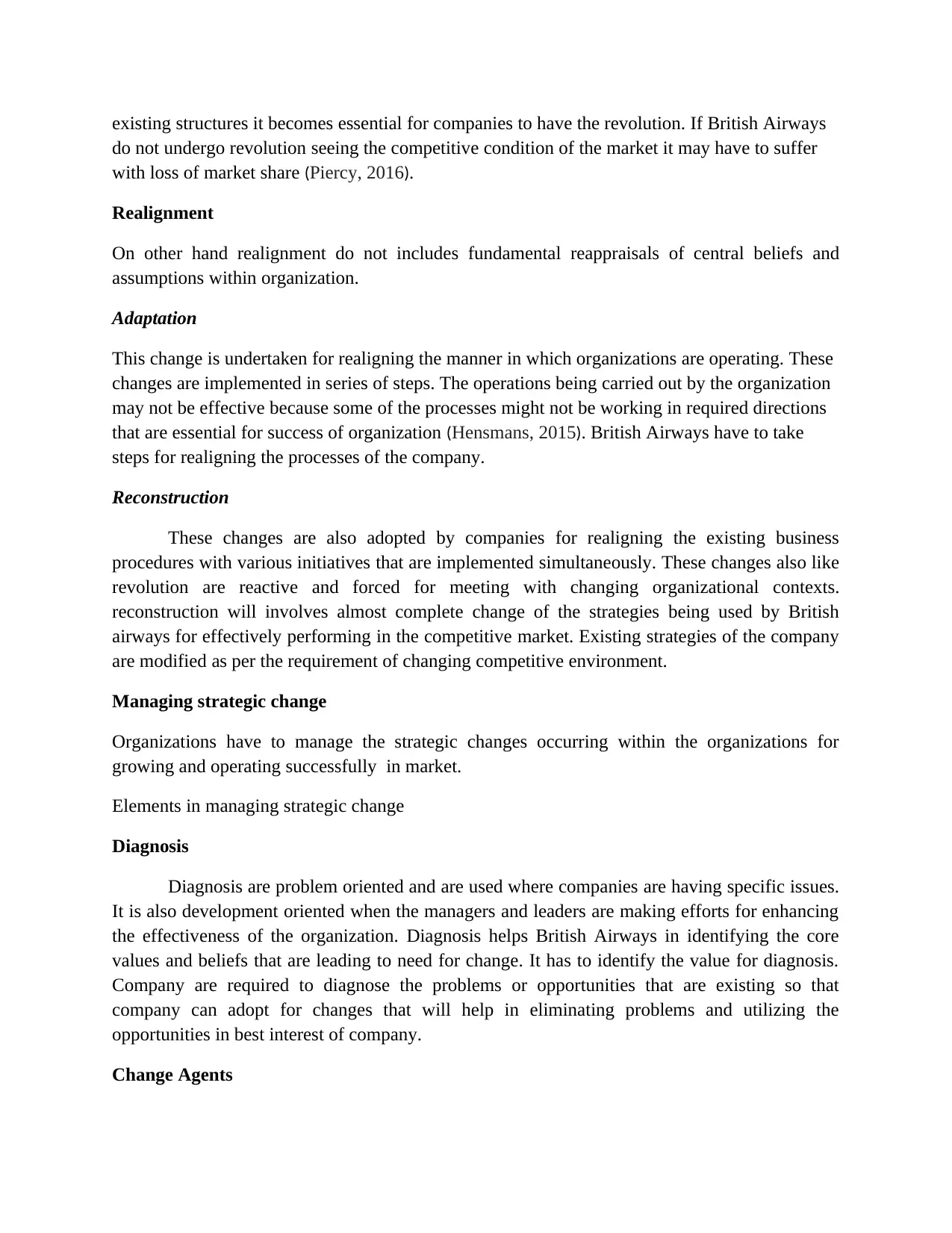
existing structures it becomes essential for companies to have the revolution. If British Airways
do not undergo revolution seeing the competitive condition of the market it may have to suffer
with loss of market share (Piercy, 2016).
Realignment
On other hand realignment do not includes fundamental reappraisals of central beliefs and
assumptions within organization.
Adaptation
This change is undertaken for realigning the manner in which organizations are operating. These
changes are implemented in series of steps. The operations being carried out by the organization
may not be effective because some of the processes might not be working in required directions
that are essential for success of organization (Hensmans, 2015). British Airways have to take
steps for realigning the processes of the company.
Reconstruction
These changes are also adopted by companies for realigning the existing business
procedures with various initiatives that are implemented simultaneously. These changes also like
revolution are reactive and forced for meeting with changing organizational contexts.
reconstruction will involves almost complete change of the strategies being used by British
airways for effectively performing in the competitive market. Existing strategies of the company
are modified as per the requirement of changing competitive environment.
Managing strategic change
Organizations have to manage the strategic changes occurring within the organizations for
growing and operating successfully in market.
Elements in managing strategic change
Diagnosis
Diagnosis are problem oriented and are used where companies are having specific issues.
It is also development oriented when the managers and leaders are making efforts for enhancing
the effectiveness of the organization. Diagnosis helps British Airways in identifying the core
values and beliefs that are leading to need for change. It has to identify the value for diagnosis.
Company are required to diagnose the problems or opportunities that are existing so that
company can adopt for changes that will help in eliminating problems and utilizing the
opportunities in best interest of company.
Change Agents
do not undergo revolution seeing the competitive condition of the market it may have to suffer
with loss of market share (Piercy, 2016).
Realignment
On other hand realignment do not includes fundamental reappraisals of central beliefs and
assumptions within organization.
Adaptation
This change is undertaken for realigning the manner in which organizations are operating. These
changes are implemented in series of steps. The operations being carried out by the organization
may not be effective because some of the processes might not be working in required directions
that are essential for success of organization (Hensmans, 2015). British Airways have to take
steps for realigning the processes of the company.
Reconstruction
These changes are also adopted by companies for realigning the existing business
procedures with various initiatives that are implemented simultaneously. These changes also like
revolution are reactive and forced for meeting with changing organizational contexts.
reconstruction will involves almost complete change of the strategies being used by British
airways for effectively performing in the competitive market. Existing strategies of the company
are modified as per the requirement of changing competitive environment.
Managing strategic change
Organizations have to manage the strategic changes occurring within the organizations for
growing and operating successfully in market.
Elements in managing strategic change
Diagnosis
Diagnosis are problem oriented and are used where companies are having specific issues.
It is also development oriented when the managers and leaders are making efforts for enhancing
the effectiveness of the organization. Diagnosis helps British Airways in identifying the core
values and beliefs that are leading to need for change. It has to identify the value for diagnosis.
Company are required to diagnose the problems or opportunities that are existing so that
company can adopt for changes that will help in eliminating problems and utilizing the
opportunities in best interest of company.
Change Agents
⊘ This is a preview!⊘
Do you want full access?
Subscribe today to unlock all pages.

Trusted by 1+ million students worldwide
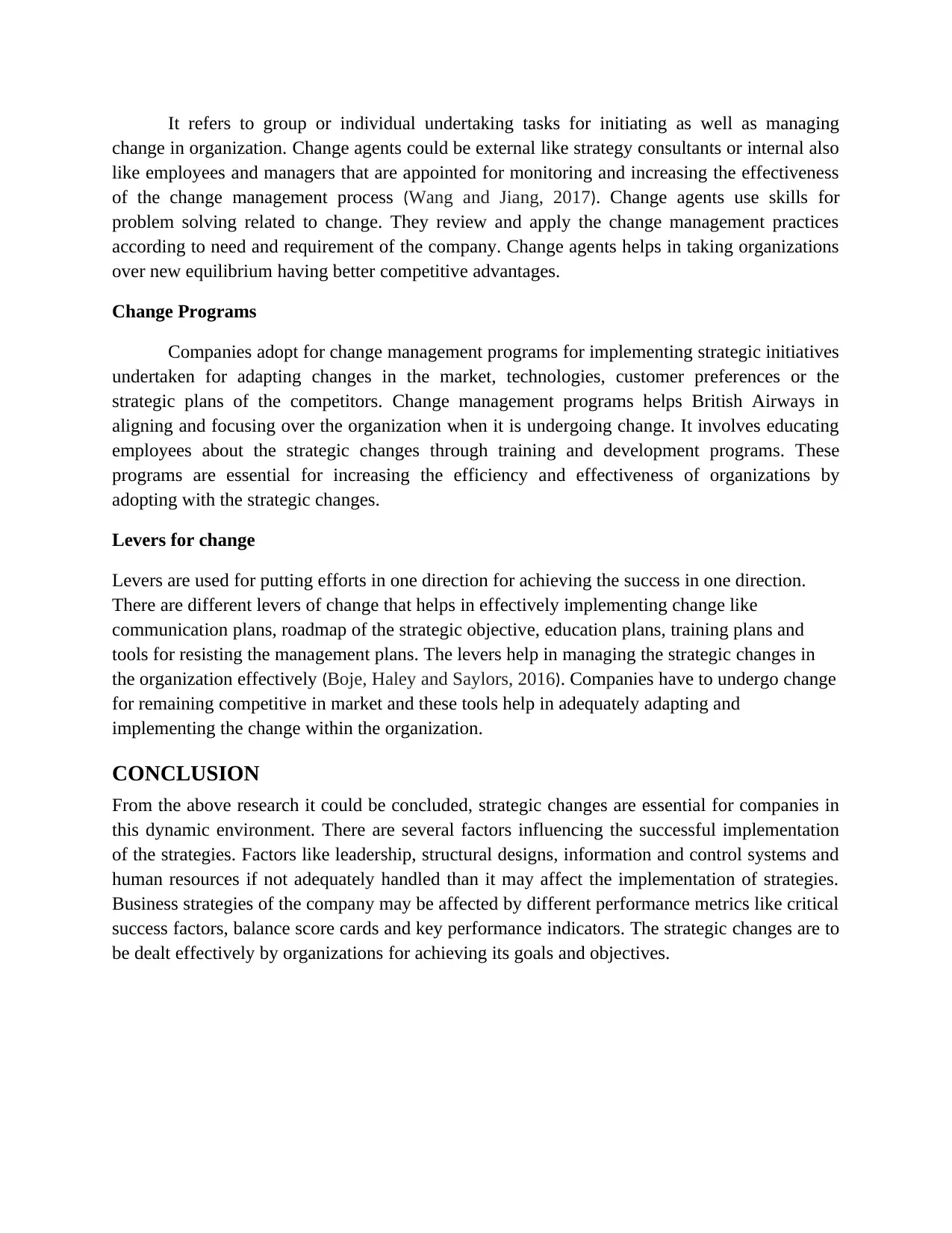
It refers to group or individual undertaking tasks for initiating as well as managing
change in organization. Change agents could be external like strategy consultants or internal also
like employees and managers that are appointed for monitoring and increasing the effectiveness
of the change management process (Wang and Jiang, 2017). Change agents use skills for
problem solving related to change. They review and apply the change management practices
according to need and requirement of the company. Change agents helps in taking organizations
over new equilibrium having better competitive advantages.
Change Programs
Companies adopt for change management programs for implementing strategic initiatives
undertaken for adapting changes in the market, technologies, customer preferences or the
strategic plans of the competitors. Change management programs helps British Airways in
aligning and focusing over the organization when it is undergoing change. It involves educating
employees about the strategic changes through training and development programs. These
programs are essential for increasing the efficiency and effectiveness of organizations by
adopting with the strategic changes.
Levers for change
Levers are used for putting efforts in one direction for achieving the success in one direction.
There are different levers of change that helps in effectively implementing change like
communication plans, roadmap of the strategic objective, education plans, training plans and
tools for resisting the management plans. The levers help in managing the strategic changes in
the organization effectively (Boje, Haley and Saylors, 2016). Companies have to undergo change
for remaining competitive in market and these tools help in adequately adapting and
implementing the change within the organization.
CONCLUSION
From the above research it could be concluded, strategic changes are essential for companies in
this dynamic environment. There are several factors influencing the successful implementation
of the strategies. Factors like leadership, structural designs, information and control systems and
human resources if not adequately handled than it may affect the implementation of strategies.
Business strategies of the company may be affected by different performance metrics like critical
success factors, balance score cards and key performance indicators. The strategic changes are to
be dealt effectively by organizations for achieving its goals and objectives.
change in organization. Change agents could be external like strategy consultants or internal also
like employees and managers that are appointed for monitoring and increasing the effectiveness
of the change management process (Wang and Jiang, 2017). Change agents use skills for
problem solving related to change. They review and apply the change management practices
according to need and requirement of the company. Change agents helps in taking organizations
over new equilibrium having better competitive advantages.
Change Programs
Companies adopt for change management programs for implementing strategic initiatives
undertaken for adapting changes in the market, technologies, customer preferences or the
strategic plans of the competitors. Change management programs helps British Airways in
aligning and focusing over the organization when it is undergoing change. It involves educating
employees about the strategic changes through training and development programs. These
programs are essential for increasing the efficiency and effectiveness of organizations by
adopting with the strategic changes.
Levers for change
Levers are used for putting efforts in one direction for achieving the success in one direction.
There are different levers of change that helps in effectively implementing change like
communication plans, roadmap of the strategic objective, education plans, training plans and
tools for resisting the management plans. The levers help in managing the strategic changes in
the organization effectively (Boje, Haley and Saylors, 2016). Companies have to undergo change
for remaining competitive in market and these tools help in adequately adapting and
implementing the change within the organization.
CONCLUSION
From the above research it could be concluded, strategic changes are essential for companies in
this dynamic environment. There are several factors influencing the successful implementation
of the strategies. Factors like leadership, structural designs, information and control systems and
human resources if not adequately handled than it may affect the implementation of strategies.
Business strategies of the company may be affected by different performance metrics like critical
success factors, balance score cards and key performance indicators. The strategic changes are to
be dealt effectively by organizations for achieving its goals and objectives.
Paraphrase This Document
Need a fresh take? Get an instant paraphrase of this document with our AI Paraphraser
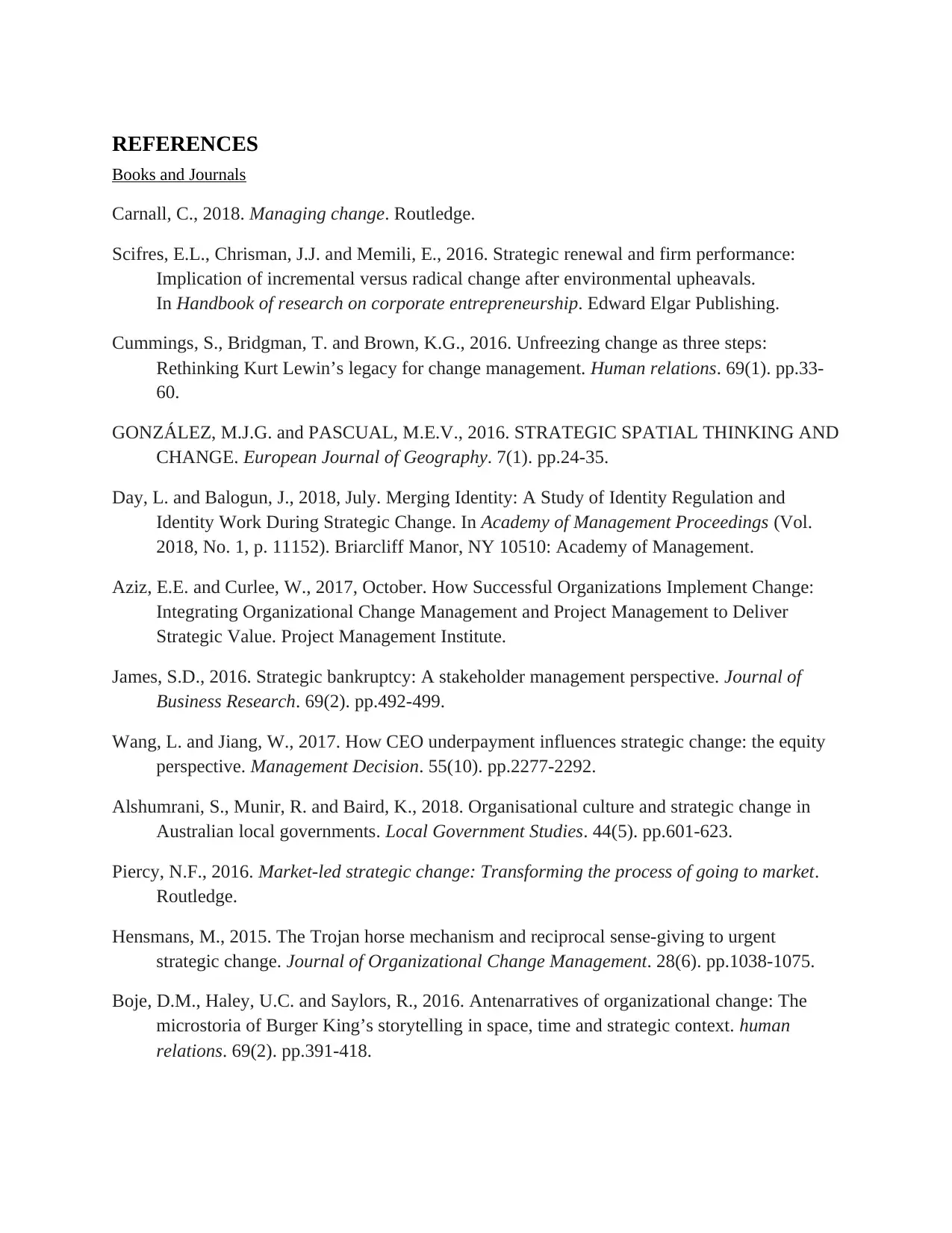
REFERENCES
Books and Journals
Carnall, C., 2018. Managing change. Routledge.
Scifres, E.L., Chrisman, J.J. and Memili, E., 2016. Strategic renewal and firm performance:
Implication of incremental versus radical change after environmental upheavals.
In Handbook of research on corporate entrepreneurship. Edward Elgar Publishing.
Cummings, S., Bridgman, T. and Brown, K.G., 2016. Unfreezing change as three steps:
Rethinking Kurt Lewin’s legacy for change management. Human relations. 69(1). pp.33-
60.
GONZÁLEZ, M.J.G. and PASCUAL, M.E.V., 2016. STRATEGIC SPATIAL THINKING AND
CHANGE. European Journal of Geography. 7(1). pp.24-35.
Day, L. and Balogun, J., 2018, July. Merging Identity: A Study of Identity Regulation and
Identity Work During Strategic Change. In Academy of Management Proceedings (Vol.
2018, No. 1, p. 11152). Briarcliff Manor, NY 10510: Academy of Management.
Aziz, E.E. and Curlee, W., 2017, October. How Successful Organizations Implement Change:
Integrating Organizational Change Management and Project Management to Deliver
Strategic Value. Project Management Institute.
James, S.D., 2016. Strategic bankruptcy: A stakeholder management perspective. Journal of
Business Research. 69(2). pp.492-499.
Wang, L. and Jiang, W., 2017. How CEO underpayment influences strategic change: the equity
perspective. Management Decision. 55(10). pp.2277-2292.
Alshumrani, S., Munir, R. and Baird, K., 2018. Organisational culture and strategic change in
Australian local governments. Local Government Studies. 44(5). pp.601-623.
Piercy, N.F., 2016. Market-led strategic change: Transforming the process of going to market.
Routledge.
Hensmans, M., 2015. The Trojan horse mechanism and reciprocal sense-giving to urgent
strategic change. Journal of Organizational Change Management. 28(6). pp.1038-1075.
Boje, D.M., Haley, U.C. and Saylors, R., 2016. Antenarratives of organizational change: The
microstoria of Burger King’s storytelling in space, time and strategic context. human
relations. 69(2). pp.391-418.
Books and Journals
Carnall, C., 2018. Managing change. Routledge.
Scifres, E.L., Chrisman, J.J. and Memili, E., 2016. Strategic renewal and firm performance:
Implication of incremental versus radical change after environmental upheavals.
In Handbook of research on corporate entrepreneurship. Edward Elgar Publishing.
Cummings, S., Bridgman, T. and Brown, K.G., 2016. Unfreezing change as three steps:
Rethinking Kurt Lewin’s legacy for change management. Human relations. 69(1). pp.33-
60.
GONZÁLEZ, M.J.G. and PASCUAL, M.E.V., 2016. STRATEGIC SPATIAL THINKING AND
CHANGE. European Journal of Geography. 7(1). pp.24-35.
Day, L. and Balogun, J., 2018, July. Merging Identity: A Study of Identity Regulation and
Identity Work During Strategic Change. In Academy of Management Proceedings (Vol.
2018, No. 1, p. 11152). Briarcliff Manor, NY 10510: Academy of Management.
Aziz, E.E. and Curlee, W., 2017, October. How Successful Organizations Implement Change:
Integrating Organizational Change Management and Project Management to Deliver
Strategic Value. Project Management Institute.
James, S.D., 2016. Strategic bankruptcy: A stakeholder management perspective. Journal of
Business Research. 69(2). pp.492-499.
Wang, L. and Jiang, W., 2017. How CEO underpayment influences strategic change: the equity
perspective. Management Decision. 55(10). pp.2277-2292.
Alshumrani, S., Munir, R. and Baird, K., 2018. Organisational culture and strategic change in
Australian local governments. Local Government Studies. 44(5). pp.601-623.
Piercy, N.F., 2016. Market-led strategic change: Transforming the process of going to market.
Routledge.
Hensmans, M., 2015. The Trojan horse mechanism and reciprocal sense-giving to urgent
strategic change. Journal of Organizational Change Management. 28(6). pp.1038-1075.
Boje, D.M., Haley, U.C. and Saylors, R., 2016. Antenarratives of organizational change: The
microstoria of Burger King’s storytelling in space, time and strategic context. human
relations. 69(2). pp.391-418.

⊘ This is a preview!⊘
Do you want full access?
Subscribe today to unlock all pages.

Trusted by 1+ million students worldwide
1 out of 12
Related Documents
Your All-in-One AI-Powered Toolkit for Academic Success.
+13062052269
info@desklib.com
Available 24*7 on WhatsApp / Email
![[object Object]](/_next/static/media/star-bottom.7253800d.svg)
Unlock your academic potential
Copyright © 2020–2025 A2Z Services. All Rights Reserved. Developed and managed by ZUCOL.




